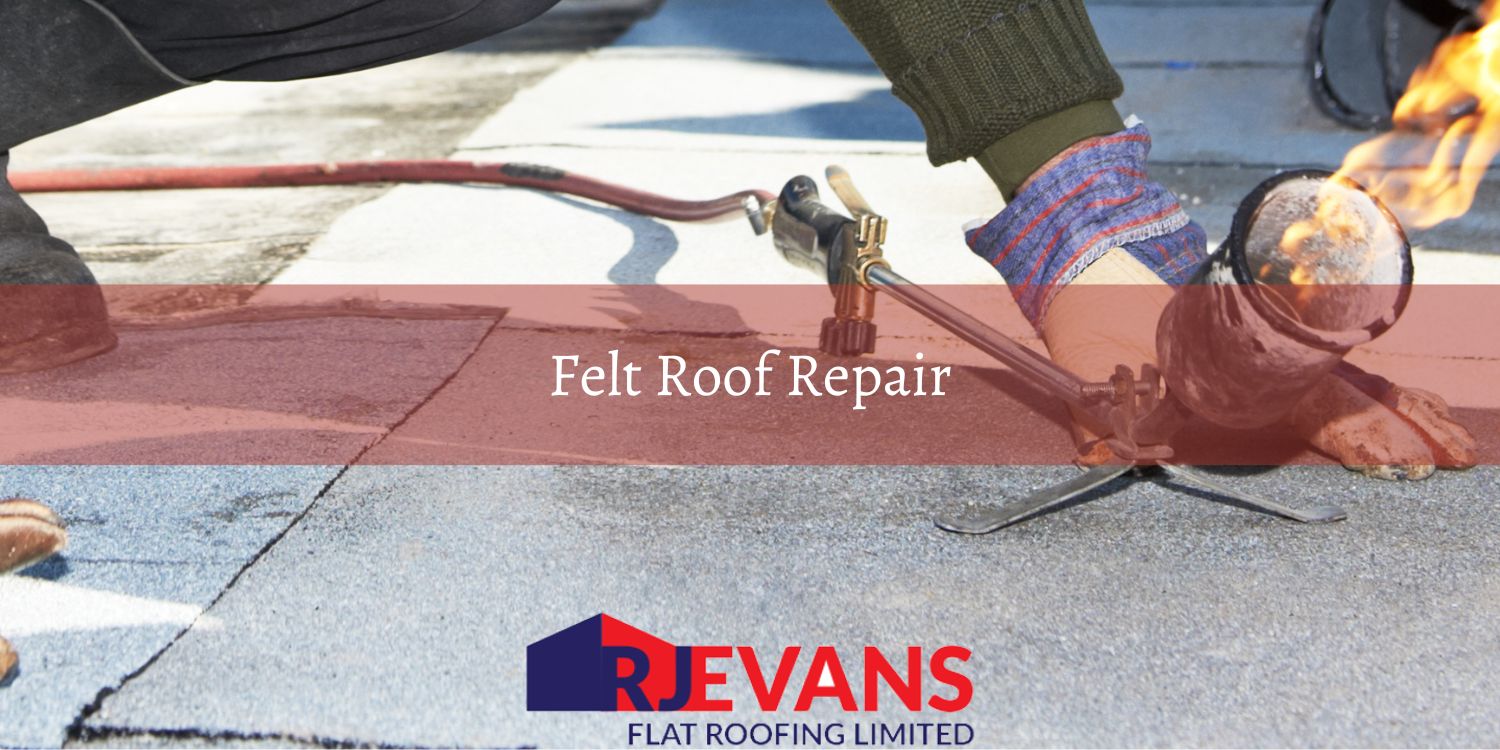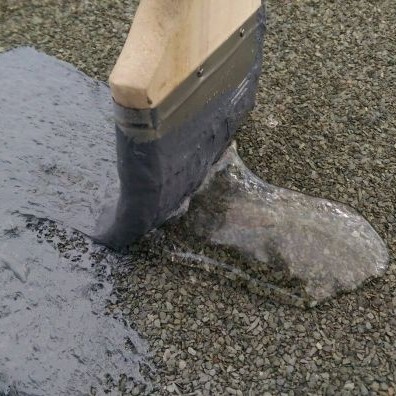I agree Our site saves small pieces of text information (cookies) on your device in order to deliver better content and for statistical purposes. You can disable the usage of cookies by changing the settings of your browser. By browsing our website without changing the browser settings you grant us permission to store that information on your device.

Felt roof repair refers to the process of addressing and remedying issues or damage which have occurred on a felt roofing system. Felt roof repairs are essential for maintaining the integrity and waterproofing capabilities of the roofing system. Common reasons for felt roof repair being required include; leaks, cracks, blistering, tearing, or deterioration of the felt material. This is often due to exposure to various weather conditions, UV radiation, or general wear and tear. Repair techniques may involve patching damaged areas, resealing seams, or applying bitumen coatings or adhesives to restore the waterproofing functionality of the roofing system. Prompt felt roof repair helps prevent further damage, reduces the risk of interior water damage, and prolongs the lifespan of the roofing system.
RJ Evans provide a complete repair service for felt roofs. Our highly-experienced felt flat roofing repair team covers all of London and the South of England, and are fully accredited felt roofing specialists. If you would like a quotation or any information about our repair service for felt flat roofs please get in touch with us or call us now on 01277 375 511.

Felt roof repair addresses the deterioration or damage to bitumen-based felt roofs, which is often caused by weather exposure, natural ageing, or physical wear and tear. Common problems include cracks, splits, blisters, and leaks, all of which compromise the roof's waterproofing and can lead to water penetration that damages the structure underneath. Minor issues, such as small cracks or holes, are typically fixed by cleaning the affected area, applying roofing adhesive or bitumen-based sealant, and patching the surface with new felt to restore its protective layer.
In more advanced cases, where the damage has spread or is more severe, larger sections of the felt or even multiple layers may need replacing. This process can involve removing the damaged felt, inspecting the underlying structure for further issues, and then applying fresh layers of felt to rebuild the roof’s waterproof barrier. Properly executed felt repairs can extend the life of the roof by several years, preventing the need for a full roof replacement, which is significantly more costly.
According to the National Federation of Roofing Contractors (NFRC), a well-maintained felt roof can last up to 20 years or more, but regular inspections and timely repairs are crucial to achieving this lifespan. Neglecting small issues can lead to more extensive damage, increasing the risk of expensive repairs or even full roof failure. Additionally, felt roofs are susceptible to damage from UV rays, which can cause the material to degrade over time. To counter this, some modern felt systems include mineral finishes or protective coatings that shield the roof from ultraviolet light, further extending its durability.
Felt roof repair is a cost-effective solution for addressing specific problem areas and maintaining the overall health of the roof. By focusing on targeted repairs, property owners can avoid the higher expenses associated with full roof replacement. Professional roofing contractors should always handle these repairs, as improper methods can lead to further damage and reduce the roof’s effectiveness in protecting the property from the elements.
Felt is always a popular choice of roofing material for flat roof extensions and outdoor buildings due to the ease of application. This popularity is further enhanced due to the low installation cost and the ease of maintenance. The main types of damage that occur to a felt flat roof are as follows: splitting, lifting and leaking. Below we explore the process for how you can carry out a temporary flat roof repair to solve these issues by using a paint-on water-based sealant.
Before you carry out any flat roof repair, you must identify the source of your problem. Normally, there are tell-tale signs from the inside of your extension or room. Looking carefully at the ceiling you may be able to sport a damp patch or water mark indicating to you were the root of the issue is. Using a tape roughly measure the distance from the nearest from the wall to where the watermark or damp patch starts.
The next step is to go up onto your roof to investigate. Using the measuring tape, you can use the rough measurement to gage the problematic area. Should you not have any tell tale signs from inside the building you should be able to notice any splits or lifting by carefully walking around the area and investigating. The things you want to look out for a any ridges of hollows, as this will be a clear indication of where the roofing structure maybe impaired. Another give away sign of this is any pooling of water. Even if you have managed to locate your roofing issue by using the rough inside measurement it never hurts to give your roof a thorough check while you are up there.
Now that you have established the area(s) that need repairing you need to try and remove as much water as possible you can do this by rubbing or patting the area with towels. The next step is to clean the area by using a broom to sweep away any dirt or moss.
You are now ready to begin the process of applying the waterproof sealant. The waterproof sealant bonds with the surface as it is painted onto the roof and drives out any remaining moisture, whilst also providing a coat that will protect the roof from any other downfall of rain. You will need to read the instructions on your sealant tin but most tend to advice that you apply the paint using a 2mm coat of thickness.
You now want to coat the problem area with the paint you want to be sure to carefully go over any joints of splits to ensure optimum coverage. You may notice as you apply the sealant that small flecks appear, these flecks form naturally in the paint but they will disappear as you work the paint into the area and you will be left with a smooth surface to your roof.
If the issue on your felt roof is that it has split or looks like it will soon split it is advisable that you use some plasterer’s scrim to reinforce this damaged area. What you need to do is measure the length of the split and cut the plasterers scrim so that it is slightly longer either end of the problem. Begin by working the paint sealant over the split then once you are happy with the coverage, apply the plasterer’s scrim. The next step is to apply another coat of the paint sealant on top of the scrim (which typically has a 2inch width). This process with then give your damaged area a three-level layer of protection.
Now that you have successfully applied your waterproof sealant you will have ensured that any of your contents under the roof won’t be ruined, whilst also buying yourself a few weeks or even potentially months to consider your options for a permanent roof repair.
Although no roof repair can ever be permanent the torch-on felt roofing approach we are going to explore below will give your roof a new lease of life, and if looked after, last you a good 20 years or more. You will also find that reputable tradesmen will offer you a 10-year guarantee on your roof which should provide you with some reassurance.
The Torch-on Felt Roofing Process:
It is first important to acknowledge the progression we have seen in the labour and composition of a felt roof. Years ago, the process often referred to as ‘pour and roll’ saw roofers using thin bitumen felt that were glued together with hot liquid bitumen1, with multiple layers then applied. Unfortunately, this process then led to short life span due to cracking and rot. The modern method, in contrast produces a stronger, superior roof.
So How Is A Modern Torch On Felt Roof Laid?
The felt comes in pre-made rolls, which the work men treat with a very large blow torch. By applying the heat to the rolls, the felt begins to melt and is then able to be moulded to the roof structure, which makes it a good choice for any size or shape roof.
Most roofers adopt the 3-layer system2 for optimum durability;
• The initial layer is a perforated underlay
• In the middle there is a 2mm underlay
• Finally, a thick 4-5mm cap sheet (the felt layer) is applied
Further to this each of these layers has a strong polyester weave in the centre of into increase the roofs sturdiness.
The manner in which the roofer applies the layers is known as ‘half lap’ and means that the roof purposefully ensures the joints are as far away from each other as possible to once again aid the roofs overall strength and durability.
It is also worth noting that there are a variety of colours for a felt roof as well as UV resistant layers3.
• Vastly experienced flat roof repair team. We have operatives with more than 40 years’ experience.
• We provide a range of FREE quotations and solutions for all flat roof repairs.
• Insurance Backed Guarantees.
• Excellent Customer Support throughout project.
• Rated 5 out of 5 from our previous customers.
If you would like a quotation or any information on felt roof repairs please get in touch with us or call us now on 01277 375 511.
.